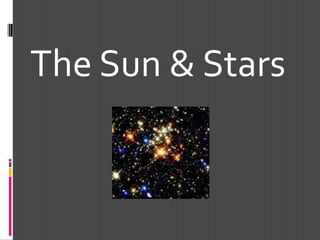Sun & stars
- 1. The Sun & Stars
- 2. What is a star? Stars are huge bodies of hot glowing gas, that give off energy in the form of heat and light.
- 3. How do stars differ from one another? Stars can be different from each other in temperature, size, an d brightness. The Hertzsprung- Russell (H-R) diagram shows these differences.
- 4. What does the color of a star tell us? The color of a star tells us its temperature. Hotter stars-blue Cooler stars-red Our sun is a yellow star.
- 5. How old is our star? Our sun is about 5 billion years old. It is a middle-aged star, meaning it has about another 5 billion years. The solar system formed at the same time as the sun, and therefore, has the same age.
- 6. What makes up our star? The sun is made up of hydrogen and helium. Inside the sun, nuclear reactions are taking place. Two atoms of hydrogen are being forced together, due to the rapid speed at which they are moving, forming helium. When this happens, large amounts of energy are being released, like atomic bombs constantly going off.
- 7. What kind of energy does the Earth get from the sun? Earth receives electromagnetic energy from the sun. This brings the light and heat from the sun to the earth. It includes such types of energy waves, such as: U-V waves Infrared waves Microwaves Gamma waves Visible light
- 8. Looking at the Hertzsprung- Russell (H-R) diagram: Absolute magnitude is how bright a star actually is The brighter a star is, the lower the absolute magnitude There are 4 groups of stars that fall into the H-R diagram (supergiants, giants, main sequence, and white dwarfs)
